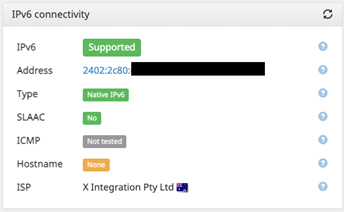IPv6
Asus RT-AX56U – IPoE – Ethernet
Asus RT-AX56U – PPPoE – Ethernet
Huawei HG659 – IPoE – Ethernet
Huawei HG659 – PPPoE – Ethernet
Mercusys MR30G – IPoE – Ethernet
Mercusys MR30G – PPPoE – Ethernet
Netcomm NF17ACV – IPoE – Ethernet
Netcomm NF18MESH – IPoE – Ethernet
Netcomm NF18MESH – PPPoE – Ethernet
Telstra Smart Modem Gen 2 – IPoE – Ethernet
TP-Link VR400 – IPoE – Ethernet
TP-Link VR400 – PPPoE – Ethernet
- Running out of IPv4 addresses – the world is running out of address space on the older protocol and we need to switch to something larger.
- Remove multiple layers of Network Address Translation (NAT). Currently, the way we get around the shortage of IPv4 addresses is by using NAT to hide private addresses behind a public address and have a device translate between the two. This has limitations that can cause problems with some games, Virtual Private Networks (VPNs) and some business applications, especially voice. IPv6 does not have NAT as we have enough address space for every single device to have its own IPv6 address.
Leaptel has been trialling IPv6 access since early 2022. Our network is built as a dual-stack environment (so both IPv4 and IPv6 together) and customers have been able to enable IPv6 via the members portal via an opt-in process. Each customer who enables the service is:
- Allocated a Global Unicast Address for their router connected to the internet
- Allocate a /56 delegation for their router to use to allocate addresses to their entire household. That is 4,722,366,482,869,645,213,696 addresses per customer.
We support IPv6 on:
- nbn® Customers connecting via PPPoE or IPoE.
- Opticomm customers connecting via PPPoE or via IPoE (in areas in which Opticomm’s infrastructure supports it).
- Lynham Networks (Lightning) areas via PPPoE.
Once your router has connected up IPv4, your router will then make a DHCP request for IPv6. At that time we will provide your router with:
- A global unicast IP address for the router’s network port to us.
- A /56 prefix delegation for your router to make IPv6 work within your home network.
What then happens is your router will take the /56 delegation and in a normal home situation it will then allocate one /64 subnet from that delegation to your local network and begin making that address space available to your devices.
No. The default configuration of most IPv6-capable residential routers will have a firewall protecting your devices from the public internet. In addition to this most devices also have their own firewall to provide another level of protection.
Many devices will also randomise the address they use to ensure that the device keeps moving around, making it difficult to predict the address your device will have, providing you with another layer of protection.
We are hoping to offer static IPv6 allocations in 2024.
Leaptel will return a /48 prefix delegation when you request IPv6.
The equipment Opticomm has installed at some locations is old and is not capable of correctly providing the Option 82 injection of your service ID to allow us to authenticate your connection. Once Opticomm upgrades the network infrastructure you will be able to get IPv6 at addresses that currently cannot.
When you go to turn on IPv6 we run a check with Opticomm to confirm if it is available and if it is not we cannot enable the protocol for you.
We would prefer you to obtain your DNS servers from DHCP however if you need to statically allocate DNS servers our servers are on our DNS page.
Leaptel uses DHCPv6-PD (Dynamic Host Configuration Protocol version 6 with Prefix Delegation) to obtain an IPv6 Global Unicast address and a prefix to use for your local network.
SLAAC (Stateless Address Autoconfiguration) is not used by Leaptel. However, it may be used by your router to then provide IPv6 within your local network and combined with DHCPv6 to then provide DNS details. You can find information on what SLAAC is and how it works here.
No, Leaptel does not use any tunnelling to support IPv6. We run a Dual Stack environment.
No. An address that begins with FE80 is called a link-local address, which only provides IPv6 connectivity to devices on the same local network. Every device on an IPv6 network will normally have 2 addresses, a link local address and a Global Unicast address which on the Leaptel network begins with “2402:”.
No, it is not required that you get a Global Unicast address. You can just request just a prefix delegation from our Broadband Network Gateways (BNGs). This will work if your router is capable.
Yes, but you need to be careful to ensure that both DHCPv4 and DHCPv6 are turned off on your access point and that you are connecting the LAN ports of your access point to the LAN ports of your router.
If you don’t do this your access point will try and request a prefix from your router. This will go unanswered which will cause issues and could lead to the access point incorrectly returning to devices that it is also a router, breaking IPv6 from working.
Easiest way is to visit https://ipv6-test.com/ and confirm that it says the IPv6 is supported.

If you are having issues and contacting support, using this link https://isp.test-ipv6.com/ and providing the results url to our support team will help us to identify what is wrong so we can assist you.

